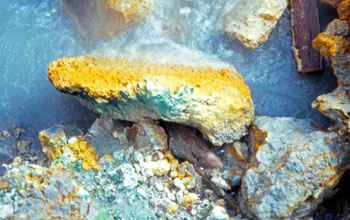
Rock in an Icelandic hot spring near Reykjavik with sulfur and Galdieria sulphuraria.
Credit: Christine Oesterhelt
Download the high-resolution JPG version of the image. (1 MB)
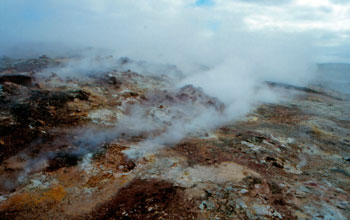
A volcanic area near Reykjavik, Iceland, where Galdieria sulphuraria has been found.
Credit: Christine Oesterhelt
Download the high-resolution JPG version of the image. (986 KB)
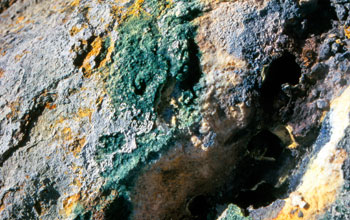
Yellow sulfur deposits and Galdieria on a rock near Reykjavik.
Credit: Christine Oesterhelt
Download the high-resolution JPG version of the image. (1.7 MB)
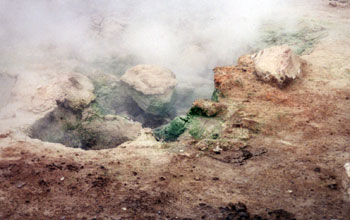
"Extremophile" Galdieria grows on rocks and soil near a Yellowstone hot spring.
Credit: Andreas Weber
Download the high-resolution JPG version of the image. (607 KB)
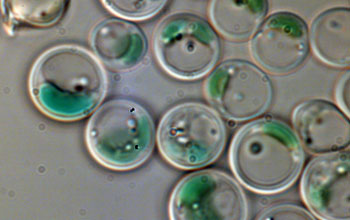
Microscope image of Galdieria sulphuraria.
Credit: Gerald Schoenknecht
Download the high-resolution JPG version of the image. (389 KB)
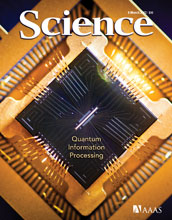
The researchers' results are described in the March 8 issue of the journal Science.
Credit: Copyright AAAS 2013
Download the high-resolution JPG version of the image. (239 KB)
In the movie Alien, the title character is an extraterrestrial creature that can survive brutal heat and resist the effects of toxins.
In real life, organisms with similar traits exist, such as the "extremophile" red alga Galdieria sulphuraria.
In hot springs in Yellowstone National Park, Galdieria uses energy from the sun to produce sugars through photosynthesis.
In
the darkness of old mineshafts in drainage as caustic as battery acid,
it feeds on bacteria and survives high concentrations of arsenic and
heavy metals.
How has a one-celled alga acquired such flexibility and resilience?
To
answer this question, an international research team led by Gerald
Schoenknecht of Oklahoma State University and Andreas Weber and Martin
Lercher of Heinrich-Heine-Universitat (Heinrich-Heine University) in
Dusseldorf, Germany, decoded genetic information in Galdieria.
They are three of 18 co-authors of a paper on the findings published in this week's issue of the journal Science.
The scientists made an unexpected discovery: Galdieria's genome shows clear signs of borrowing genes from its neighbors.
Many genes that contribute to Galdieria's adaptations were not inherited from its ancestor red algae, but were acquired from bacteria or archaebacteria.
This "horizontal gene transfer" is typical for the evolution of bacteria, researchers say.
However, Galdieria
is the first known organism with a nucleus (called a eukaryote) that
has adapted to extreme environments based on horizontal gene transfer.
"The
age of comparative genome sequencing began only slightly more than a
decade ago, and revealed a new mechanism of evolution--horizontal gene
transfer--that would not have been discovered any other way," says Matt
Kane, program director in the National Science Foundation's (NSF)
Division of Environmental Biology, which funded the research.
"This finding extends our understanding of the role that this mechanism plays in evolution to eukaryotic microorganisms."
"This finding extends our understanding of the role that this mechanism plays in evolution to eukaryotic microorganisms."
Galdieria's
heat tolerance seems to come from genes that exist in hundreds of
copies in its genome, all descending from a single gene the alga copied
millions of years ago from an archaebacterium.
"The results give
us new insights into evolution," Schoenknecht says. "Before this, there
was not much indication that eukaryotes acquire genes from bacteria."
The
alga owes its ability to survive the toxic effects of such elements as
mercury and arsenic to transport proteins and enzymes that originated in
genes it swiped from bacteria.
It also copied genes offering
tolerance to high salt concentrations, and an ability to make use of a
wide variety of food sources. The genes were copied from bacteria that
live in the same extreme environment as Galdieria.
"Why reinvent the wheel if you can copy it from your neighbor?" asks Lercher.
"It's
usually assumed that organisms with a nucleus cannot copy genes from
different species--that's why eukaryotes depend on sex to recombine
their genomes.
"How has Galdieria managed to overcome this limitation? It's an exciting question."
What Galdieria did is "a dream come true for biotechnology," says Weber.
"Galdieria
has acquired genes with interesting properties from different
organisms, integrated them into a functional network and developed
unique properties and adaptations."
In the future, genetic engineering may allow other algae to make use of the proteins that offer stress tolerance to Galdieria.
Such
a development would be relevant to biofuel production, says
Schoenknecht, as oil-producing algae don't yet have the ability to
withstand the same extreme conditions as Galdieria.
-NSF-
Media Contacts
Cheryl Dybas, NSF (703) 292-7734 cdybas@nsf.gov
The National Science Foundation (NSF) is an independent federal
agency that supports fundamental research and education across all
fields of science and engineering. In fiscal year (FY) 2012, its budget
is $7.0 billion. NSF funds reach all 50 states through grants to nearly
2,000 colleges, universities and other institutions. Each year, NSF
receives over 50,000 competitive requests for funding, and makes about
11,000 new funding awards. NSF also awards nearly $420 million in
professional and service contracts yearly.
Useful NSF Web Sites:
NSF Home Page: http://www.nsf.gov
NSF News: http://www.nsf.gov/news/
For the News Media: http://www.nsf.gov/news/newsroom.jsp
Science and Engineering Statistics: http://www.nsf.gov/statistics/
Awards Searches: http://www.nsf.gov/awardsearch/
NSF Home Page: http://www.nsf.gov
NSF News: http://www.nsf.gov/news/
For the News Media: http://www.nsf.gov/news/newsroom.jsp
Science and Engineering Statistics: http://www.nsf.gov/statistics/
Awards Searches: http://www.nsf.gov/awardsearch/
The National Science Foundation (NSF).
Guillermo Gonzalo Sánchez Achutegui
ayabaca@gmail.com
ayabaca@hotmail.com
ayabaca@yahoo.com
Inscríbete en el Foro del blog y participa : A Vuelo De Un Quinde - El Foro!

No hay comentarios:
Publicar un comentario